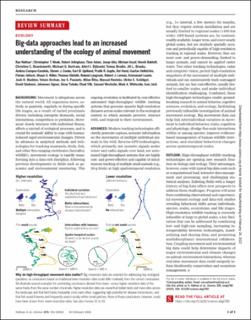| dc.contributor.author | Ran, Nathan | |
| dc.contributor.author | Monk, Christopher T. | |
| dc.contributor.author | Arlinghaus, Robert | |
| dc.contributor.author | Adam, Timo | |
| dc.contributor.author | Alós, Josep | |
| dc.contributor.author | Assaf, Michael | |
| dc.contributor.author | Baktoft, Henrik | |
| dc.contributor.author | Beardsworth, Christine E. | |
| dc.contributor.author | Bertram, Michael G. | |
| dc.contributor.author | Bijleveld, Allert I. | |
| dc.contributor.author | Brodin, Tomas | |
| dc.contributor.author | Brooks, Jill L. | |
| dc.contributor.author | Campos-Candela, Andrea | |
| dc.contributor.author | Cooke, Steven J. | |
| dc.contributor.author | Gjelland, Karl Øystein | |
| dc.contributor.author | Gupte, Pratik R. | |
| dc.contributor.author | Harel, Roi | |
| dc.contributor.author | Hellstrom, Gustav | |
| dc.contributor.author | Jeltsch, Florian | |
| dc.contributor.author | Killen, Shaun S. | |
| dc.contributor.author | Klefoth, Thomas | |
| dc.contributor.author | Langrock, Roland | |
| dc.contributor.author | Lennox, Robert | |
| dc.contributor.author | Lourie, Emmanuel | |
| dc.contributor.author | Madden, Joah R. | |
| dc.contributor.author | Orchan, Yotam | |
| dc.contributor.author | Pauwels, Ine S. | |
| dc.contributor.author | Říha, Milan | |
| dc.contributor.author | Roeleke, Manuel | |
| dc.contributor.author | Schlägel, Ulrike E. | |
| dc.contributor.author | Shohami, David | |
| dc.contributor.author | Signer, Johannes | |
| dc.contributor.author | Toledo, Sivan | |
| dc.contributor.author | Vilk, Ohad | |
| dc.contributor.author | Westrelin, Samuel | |
| dc.contributor.author | Whiteside, Mark A. | |
| dc.contributor.author | Jarić, Ivan | |
| dc.date.accessioned | 2022-08-04T10:48:25Z | |
| dc.date.available | 2022-08-04T10:48:25Z | |
| dc.date.created | 2022-02-24T10:36:29Z | |
| dc.date.issued | 2022 | |
| dc.identifier.issn | 0036-8075 | |
| dc.identifier.uri | https://hdl.handle.net/11250/3010125 | |
| dc.description.abstract | Understanding animal movement is essential to elucidate how animals interact, survive, and thrive in a changing world. Recent technological advances in data collection and management have transformed our understanding of animal “movement ecology” (the integrated study of organismal movement), creating a big-data discipline that benefits from rapid, cost-effective generation of large amounts of data on movements of animals in the wild. These high-throughput wildlife tracking systems now allow more thorough investigation of variation among individuals and species across space and time, the nature of biological interactions, and behavioral responses to the environment. Movement ecology is rapidly expanding scientific frontiers through large interdisciplinary and collaborative frameworks, providing improved opportunities for conservation and insights into the movements of wild animals, and their causes and consequences. | en_US |
| dc.language.iso | eng | en_US |
| dc.title | Big-data approaches lead to an increased understanding of the ecology of animal movement | en_US |
| dc.type | Peer reviewed | en_US |
| dc.type | Journal article | en_US |
| dc.description.version | publishedVersion | en_US |
| dc.rights.holder | © 2022 The Authors, , some rights reserved; exclusive licensee American Association for the Advancement of Science. No claim to original U.S. Government Works | en_US |
| dc.subject.nsi | VDP::Zoologiske og botaniske fag: 480 | en_US |
| dc.subject.nsi | VDP::Zoology and botany: 480 | en_US |
| dc.source.volume | 375 | en_US |
| dc.source.journal | Science | en_US |
| dc.source.issue | 734 | en_US |
| dc.identifier.doi | 10.1126/science.abg1780 | |
| dc.identifier.cristin | 2005073 | |
| dc.relation.project | Norges forskningsråd: 294926 | en_US |
| cristin.ispublished | true | |
| cristin.fulltext | original | |
| cristin.qualitycode | 2 | |
